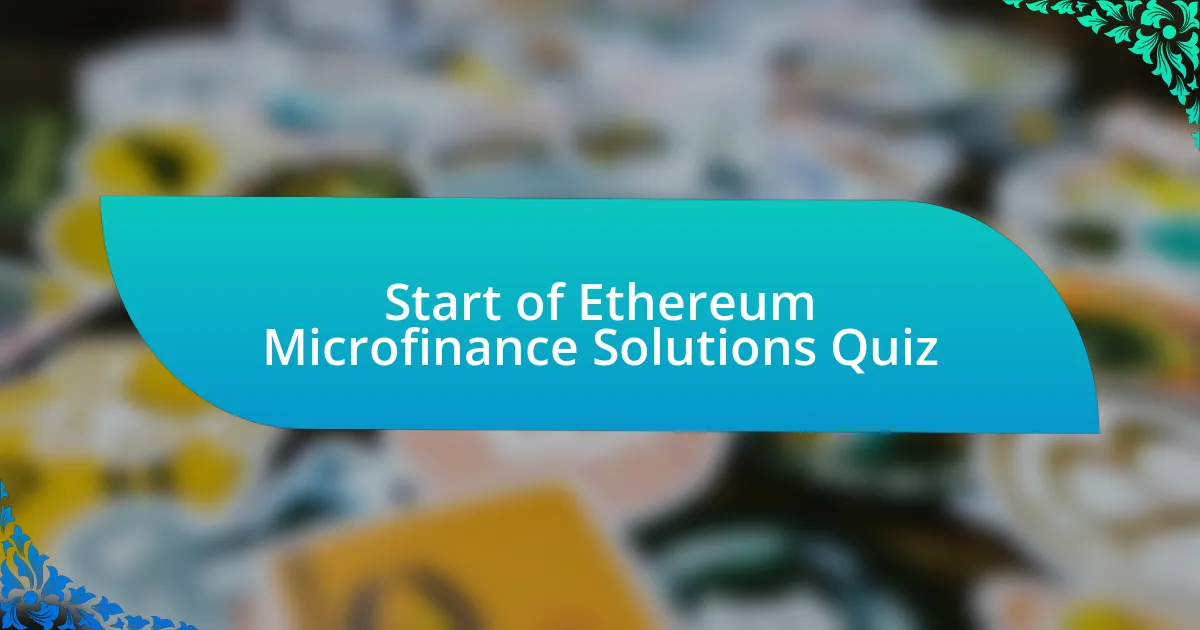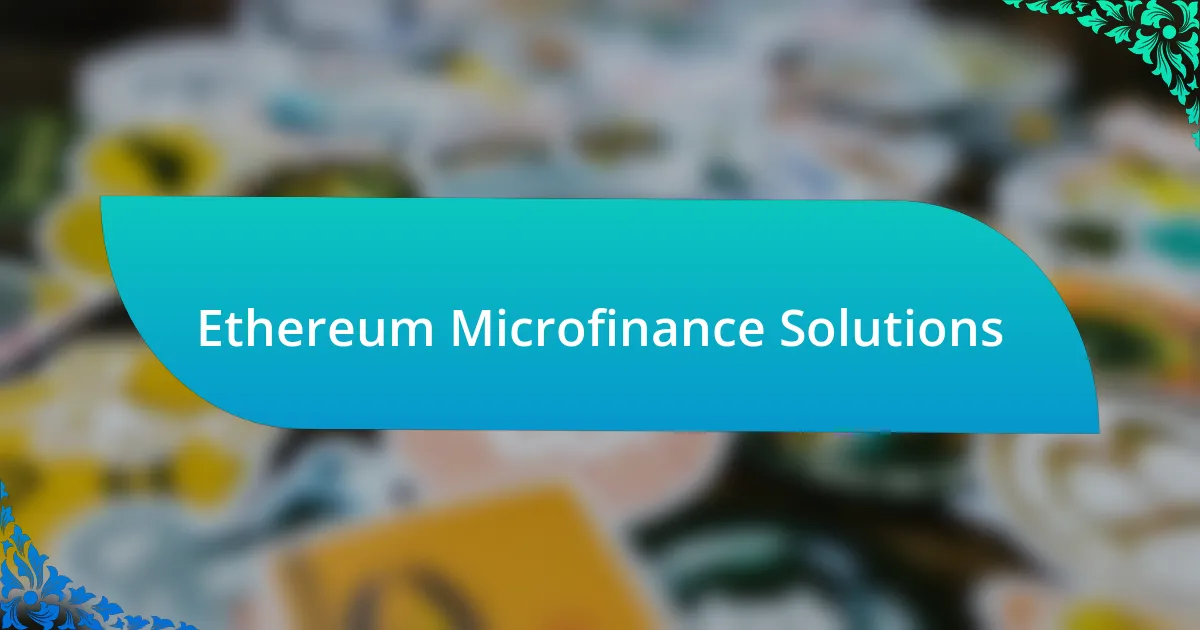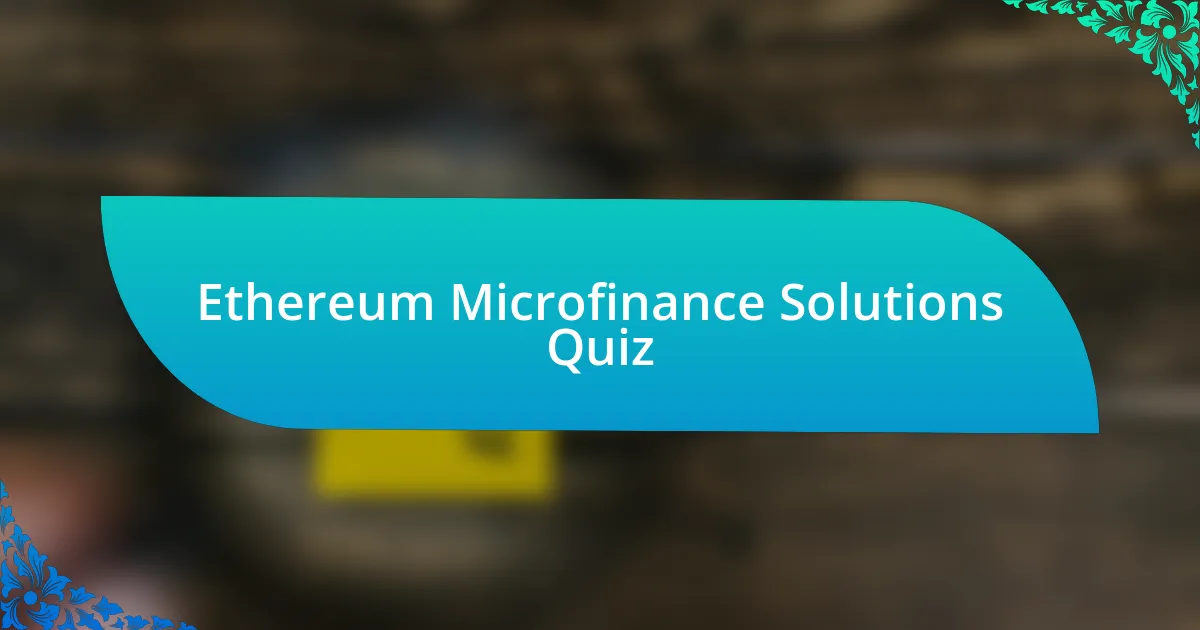
Start of Ethereum Microfinance Solutions Quiz
1. What are the key features of Ethereum that make it suitable for microfinance solutions?
- Ethereum requires a centralized authority to manage microfinance transactions.
- Ethereum complicates access to credit by increasing fees for borrowers.
- Ethereum limits access to financial services, making them costly and inefficient.
- Ethereum enhances financial inclusion through decentralization and low transaction costs.
2. How do decentralized finance (DeFi) applications leverage Ethereum for microfinance?
- Ethereum provides low-cost access to financial services via smart contracts.
- Ethereum uses complex legal contracts for all financial transactions.
- Ethereum eliminates the need for microfinance by focusing on large loans.
- Ethereum restricts access to financial services through traditional banks.
3. What role do governance tokens play in Ethereum-based microfinance systems?
- Governance tokens serve as collateral for loans.
- Governance tokens increase transaction fees on the network.
- Governance tokens are used to store cryptocurrencies.
- Governance tokens provide voting rights to stakeholders.
4. How can Ethereum-based microfinance platforms ensure compliance with local regulations?
- Ignore local laws and operate solely on global blockchain standards.
- Restrict access to the platform based solely on geographical location.
- Collaborate with local regulatory bodies to establish compliance frameworks.
- Eliminate all transaction fees for users without proper communication.
5. What advantages does Ethereum offer over traditional microfinance institutions?
- Ethereum offers low-cost and accessible services for individuals lacking traditional options.
- Ethereum guarantees profit for microfinance institutions without risk.
- Ethereum provides high-interest loans to all borrowers regardless of credit history.
- Ethereum eliminates all financial regulations for microfinance institutions.
6. How does Ethereum facilitate peer-to-peer lending in microfinance?
- Ethereum enables peer-to-peer lending through smart contracts and decentralized applications.
- Ethereum simplifies peer-to-peer lending through manual processing and paperwork.
- Ethereum facilitates peer-to-peer lending by using traditional banking systems for transactions.
- Ethereum allows peer-to-peer lending by offering high-interest loans from centralized institutions.
7. What impact does Ethereum have on the speed of transaction processing in microfinance?
- Ethereum has no effect on transaction speed in microfinance.
- Ethereum enhances transaction speed significantly in microfinance.
- Ethereum slows down transaction processing in microfinance.
- Ethereum makes transaction processing more complex in microfinance.
8. How can Ethereum-based microfinance platforms engage with unbanked populations?
- By offering traditional bank services to everyone involved.
- By creating physical branches in rural areas for support.
- By requiring users to have high-end computers for access.
- By providing low-cost, accessible financial services via mobile applications.
9. In what way does Ethereum`s programmability benefit microfinance applications?
- Ethereum enables automated loan processing, ensuring efficiency and reducing fraud risk.
- Ethereum prioritizes profits over accessibility in microfinance.
- Ethereum requires high transaction fees for low-value loans.
- Ethereum allows traditional banks to offer larger loans to everyone.
10. How can smart contracts be tailored for different microfinance products on Ethereum?
- Smart contracts are limited to automatically transferring assets with no relevance to loan agreements.
- Smart contracts can be customized for microfinance products by defining specific loan terms, repayment schedules, and interest rates within the code.
- Smart contracts cannot be customized and only execute predefined actions.
- Smart contracts are exclusively for cryptocurrency transactions with no application in microfinance.
11. What is the potential of Ethereum in creating global microfinance networks?
- Ethereum enables low-cost financial services through decentralized networks.
- Ethereum creates exclusive markets for wealthy investors.
- Ethereum restricts access to traditional banking systems entirely.
- Ethereum eliminates the need for any technological infrastructure.
12. How does Ethereum affect cross-border transactions in microfinance?
- Ethereum provides low-cost transaction solutions for cross-border payments in microfinance.
- Ethereum increases transaction fees for international remittances in microfinance.
- Ethereum solely focuses on domestic transactions, ignoring international needs in microfinance.
- Ethereum complicates cross-border transactions due to regulatory issues in microfinance.
13. What role does user experience play in adopting Ethereum-based microfinance solutions?
- User experience ensures accessibility and usability, driving higher adoption rates of Ethereum-based microfinance solutions.
- User experience hinders efficiency by complicating processes, leading to confusion among borrowers.
- User experience does not impact adoption, as users prioritize interest rates over usability.
- User experience only pertains to mobile applications, not affecting overall Ethereum systems.
14. How can microfinance institutions utilize Ethereum for risk assessment?
- By utilizing smart contracts to automate the evaluation of borrower data.
- By relying solely on traditional credit scores for loan approvals.
- By conducting in-person interviews with every applicant before approving loans.
- By requiring all borrowers to provide physical collateral for loans.
15. What are the barriers to entry for microfinance institutions using Ethereum?
- High transaction fees
- Excessive regulatory support
- Abundance of financial advisors
- Lack of infrastructure
16. How does Ethereum improve data sharing across microfinance networks?
- Ethereum improves data sharing by centralizing information on a single server.
- Ethereum enhances data sharing through manual paperwork and traditional databases.
- Ethereum enhances data sharing by using decentralized blockchain technology for secure transactions.
- Ethereum improves data sharing by eliminating all types of financial data.
17. What measures can be taken to enhance user trust in Ethereum-based microfinance solutions?
- Offering free loans to all users
- Using only cash transactions
- Limiting access to experienced users
- Implementing strong data encryption protocols
18. How can Ethereum aid in the transparency of microfinance loan disbursements?
- Ethereum offers a transparent ledger for loan disbursements.
- Ethereum automatically approves all loan requests without checks.
- Ethereum eliminates the need for loan agreements entirely.
- Ethereum provides high interest rates for microfinance loans.
19. What is the relationship between Ethereum and microfinance client profiles?
- Ethereum automates the credit scoring process for microfinance institutions.
- Ethereum provides low-cost financial services to improve microfinance client profiles.
- Ethereum helps banks enhance their loan processes for microfinance clients.
- Ethereum creates traditional banking profiles for microfinance clients.
20. How do Ethereum-based systems tackle issues of borrower privacy?
- Ethereum relies on public ledgers to share all borrower information.
- Ethereum uses identity verification to ensure borrower transparency.
- Ethereum uses zero-knowledge proofs to maintain borrower anonymity.
- Ethereum encrypts all transactions in a centralized database.
21. What methodologies can be employed to measure the success of Ethereum microfinance projects?
- Waterfall project management
- Six Sigma quality management
- Agile development framework
- Design science research methodology
22. How does the use of Ethereum impact the financial literacy of microfinance clients?
- Ethereum introduces complicated investment strategies, confusing microfinance clients.
- Ethereum provides low-cost, transparent financial services, enhancing literacy for microfinance clients.
- Ethereum increases reliance on traditional banks, hindering financial literacy for microfinance clients.
- Ethereum solely focuses on high-net-worth individuals, neglecting microfinance clients.
23. What are the implications of Ethereum’s smart contracts for microfinance repayment models?
- Smart contracts require traditional banks for microfinance transactions.
- Smart contracts increase accountability by providing real-time tracking of repayments.
- Smart contracts eliminate the need for all financial oversight in microfinance.
- Smart contracts complicate repayment models with extensive paperwork.
24. How can community engagement influence the success of Ethereum microfinance initiatives?
- Community engagement primarily focuses on promoting cryptocurrency among investors.
- Community engagement is irrelevant to the success of Ethereum microfinance initiatives.
- Community engagement fosters trust and awareness, enhancing participation in Ethereum microfinance initiatives.
- Community engagement leads to increased transaction fees in Ethereum microfinance projects.
25. In what ways can Ethereum`s security features address the challenges in microfinance?
- Ethereum increases the complexity of transactions, making microfinance more challenging.
- Ethereum`s main role is merely to provide a digital wallet for cryptocurrencies.
- By enabling secure transactions through smart contracts, Ethereum reduces fraud in microfinance.
- Ethereum has no impact on microfinance security features, as it is primarily for cryptocurrencies.
26. What future trends can we anticipate for Ethereum in the microfinance sector?
- Ethereum enhances financial inclusion by providing decentralized financial services to underserved populations.
- Ethereum reduces transparency, making it difficult to track transactions in microfinance.
- Ethereum increases interest rates for traditional loan services, restricting access for borrowers.
- Ethereum relies on centralized institutions to manage loan approvals and disbursements.
27. How do integrations with other blockchains improve Ethereum-based microfinance solutions?
- They allow for cross-chain asset transfers and increased liquidity.
- They permanently increase Ethereum`s transaction speed and limits.
- They ensure that all transactions are anonymous and untraceable.
- They eliminate the need for smart contracts entirely.
28. What lessons can be learned from existing Ethereum microfinance initiatives?
- Ethereum enhances financial inclusion by offering decentralized and transparent financial services.
- Ethereum increases traditional banking profits for underserved populations.
- Ethereum restricts access to financial services for rural areas.
- Ethereum focuses solely on cryptocurrency trading for microfinance.
29. How can microfinance practitioners leverage blockchain analytics on Ethereum?
- By tracking transaction patterns to assess borrower creditworthiness.
- By requiring physical collateral to secure loans.
- By storing user data in centralized databases.
- By eliminating all loan applications entirely.
30. What features of Ethereum foster innovation in microfinance services?
- Decentralized and transparent financial services
- High interest rates and fees
- Traditional banking system integration
- Heavy reliance on intermediaries

Quiz Completed Successfully!
Congratulations on completing the quiz on Ethereum Microfinance Solutions! We hope you found the experience engaging and insightful. Quizzes like this not only test your knowledge but also spark curiosity and deepen your understanding of the subject matter. You’ve explored key concepts of how Ethereum can revolutionize microfinance, offering new opportunities for underserved communities.
Throughout the quiz, you likely discovered how blockchain technology can enhance transparency and accessibility in financial services. You may have also learned about the potential of decentralized applications to create innovative lending platforms. These insights can empower you to think critically about the future of finance and the important role Ethereum plays in it.
We invite you to further your learning by checking out the next section on this page, which delves deeper into the topic of Ethereum Microfinance Solutions. There, you will find more detailed information that can enhance your knowledge and understanding of this transformative technology. Your journey into the world of Ethereum continues, and we are excited to support you along the way!

Ethereum Microfinance Solutions
Understanding Ethereum for Microfinance Solutions
Ethereum is a decentralized blockchain platform that enables smart contracts and decentralized applications (dApps). These features allow for secure and transparent financial transactions without intermediaries. In microfinance, Ethereum can streamline lending and borrowing processes. It reduces costs and increases accessibility, particularly in underserved markets. Users can engage in peer-to-peer lending, remittances, and more.
The Role of Smart Contracts in Ethereum Microfinance
Smart contracts are self-executing contracts with the terms directly written into code. In microfinance, they automate processes like loan disbursement and repayment schedules. This automation enhances efficiency and trust between parties. For instance, a smart contract can ensure that a loan is only disbursed when certain conditions are met, reducing default risk.
Benefits of Ethereum-Based Microfinance Solutions
Ethereum microfinance solutions offer several benefits. They provide greater access to financial services for unbanked populations. Transactions are traceable and secure, which builds trust. Lower operational costs enable competitive interest rates. Additionally, Ethereum’s global nature allows cross-border transactions without hefty fees.
Challenges Facing Ethereum Microfinance Initiatives
Despite its potential, Ethereum microfinance faces challenges. High transaction fees during network congestion can deter users. Regulatory uncertainty may hinder adoption in various regions. Technical literacy is required for users to navigate the platform effectively. Finally, the volatility of Ethereum’s currency can impact loan values and repayments.
Case Studies of Successful Ethereum Microfinance Projects
Numerous projects illustrate the effectiveness of Ethereum in microfinance. For example, projects like Kiva have explored blockchain for tracking loans and ensuring fund usage. Startups like Celo leverage Ethereum’s technology for mobile-based financial services, facilitating micro-loans. These examples highlight how Ethereum can enhance financial inclusion and efficiency in microfinance sectors.
What are Ethereum Microfinance Solutions?
Ethereum Microfinance Solutions are financial services and products built on the Ethereum blockchain aimed at providing small-scale loans and financial assistance to individuals and businesses. They utilize smart contracts to facilitate transactions, ensuring transparency and reducing costs. For example, platforms like Aave and Compound offer decentralized financing options that allow users to lend and borrow with minimal fees and no intermediaries.
How do Ethereum Microfinance Solutions work?
Ethereum Microfinance Solutions operate through decentralized applications (dApps) that leverage smart contracts to automate lending processes. Users can deposit cryptocurrencies into these dApps, creating liquidity pools for borrowers. Borrowers can then access these funds by providing collateral, which ensures the safety of lenders. This process is executed without the need for traditional banks, thus lowering overhead costs and increasing accessibility.
Where can you find Ethereum Microfinance Solutions?
You can find Ethereum Microfinance Solutions on various decentralized finance (DeFi) platforms such as Aave, Compound, and MakerDAO. Each of these platforms allows users to engage in microfinance activities like lending, borrowing, and earning interest on their digital assets. These platforms are accessible through web interfaces and decentralized wallets that support Ethereum transactions.
When did Ethereum Microfinance Solutions become popular?
Ethereum Microfinance Solutions gained popularity in 2020, coinciding with the broader DeFi movement. The emergence of various protocols during this time demonstrated the potential for Ethereum to disrupt traditional finance. The total value locked in DeFi reached over $15 billion in early 2021, indicating significant user interest and adoption of these innovative financial services.
Who benefits from Ethereum Microfinance Solutions?
Individuals and small businesses in underserved markets benefit significantly from Ethereum Microfinance Solutions. These solutions provide easier access to credit, offering financial services to those previously excluded by traditional institutions. Additionally, investors and cryptocurrency holders can earn passive income by lending their assets on DeFi platforms, thus creating a mutual benefit for both lenders and borrowers.

